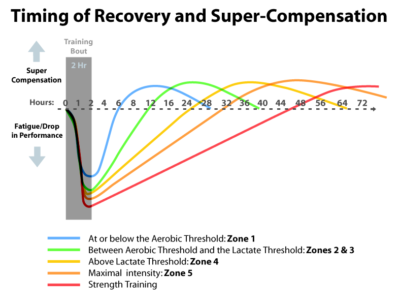How Training Works
By: Scott Johnston
Posted:
You read that correctly. It is one of the most misunderstood sports training principles.
Exposing your body to a stressor that disturbs the homeostasis of one or several of your body’s systems causes a multitude of adaptive responses that help prepare your body for similar stress imposed in the future. That works if these imposed stresses (we call workouts) are not too demanding or too frequent and have a sufficient recovery to allow enough time for the adaptive processes to occur. The General Adaptation Syndrome (GAS) was first proposed by Hungarian endocrinologist Hans Selye around 1950. While his research focused on illness, the principles also apply to training.
The hours to days between training sessions are when these critical adaptations occur. It should then come as no surprise that what you do following a training session can impact your body’s response. From practicing yoga to eating well to integrating self-massage, many strategies can facilitate a faster and more complete recovery allowing the benefit from the next bout of training to happen sooner.
What’s going on to cause these adaptations to occur after an endurance training session can best be described as a cascade of events, one leading to the next, as illustrated in the chart above that I made for use in our books. Notice that the training stimulus causes stress to your cellular metabolism. This cascade results in metabolic adaptations deep inside the working muscles leading to improved endurance performance. Therein lies one of the most important concepts in training for endurance activities.
Endurance improves by changing the muscle cells’ metabolism. I will discuss this process in more detail in an upcoming article.
Training does not produce instantaneous or steadily increasing gains. Immediately after a training session, your performance of the same tasks you were training will be diminished. It is only after a period of recovery that your fitness/performance returns to and exceeds its previous level. This drop in performance, followed by a rebound, is known as the training effect. The following graphic from Training for the New Alpinism and Training for the Uphill Athlete illustrates three phases: First, you drive yourself into a state of fatigue which starts that cascade. Next, you allow sufficient recovery time for the adaptations to the training stimuli to occur, and finally, the result is the supercompensation phase, where performance gains are realized.
If you impose too little training stimulus, you will only see a tiny supercompensation. Too large a stimulus, driving you into profound fatigue, you won’t recover for so long that the adaptations will occur and then wane by the time you’ve recovered. The art of training is finding just the right load to apply to get a nice supercompensation and train again while in that super compensated phase of recovery.
At least, that’s the theory. In practice, things get more complex because a training session rarely imposes a single stimulus. Since different physiologic systems recover at different rates, the timing of the supercompensation phase gets a little muddied. The theory does not fail us. It is just too simple to fully explain the situation on the ground.
I like to quote mathematician George Box who, when describing models (theories) that describe the real world:
I hope you will agree that this one is also useful, if not 100% correct.
The following graphic, courtesy of Jan Olbrecht in his book Science of Winning, shows the rate of recovery from various types of training stimuli in a more quantitative way. One training session often imposes several stimuli at once, and timing the recovery well for one will not suit another. Nailing the training load and timing is what makes training work or not.
